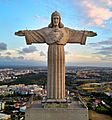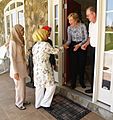Tourism facts for kids
Tourism is all about people traveling for fun and new experiences! It includes exciting activities like exploring new places (sightseeing) and staying outdoors (camping). When people travel for enjoyment, they are called "tourists." Places that many tourists visit and stay in are known as "resorts" or "tourist destinations."
People travel for many different reasons:
- Some tourists want to learn about the history or culture of a city or country. They might be curious about the people who live there or their ancestors.
- People from cold places often love to relax in the sun. Many visitors from northern Europe or North America travel to warmer spots to enjoy the beaches.
- Others travel to do activities they cannot do at home. For example, there are many ski resorts in the mountains of Switzerland and Austria. You can also find fun seaside resorts in Greece and other warm countries.
- Sometimes, people visit friends and family who live in another city or country.
- Finally, some people simply enjoy seeing a different landscape or scenery. City dwellers might go to forests or deserts, and people from rural areas might visit big cities.
Contents
What is the Tourism Industry?
The tourism industry is a huge business that helps people travel. It has many different parts working together to make your trips possible.
How Do Tourists Travel?
One big part of the industry is transport. This includes:
- Airlines that fly you to distant places.
- Railways (trains) that take you across countries.
- Boats and ships for sea travel or cruises.
- Road transport like buses, taxis, and rental cars.
Where Do Tourists Stay?
Another important part is providing places to stay. These can be:
- Comfortable hotels.
- Camping grounds or parks where you can set up a tent.
- Youth hostels, which are affordable places for young travelers.
- Bed and breakfasts, which are smaller, cozy places to stay.
What Do Tourists Eat and Drink?
The tourism industry also covers food and drink. This means:
- Restaurants where you can enjoy meals.
- Cafés for snacks and drinks.
- Bars for adult beverages (though these are not for kids!).
What is Mass Tourism?
Mass tourism happens when large groups of people travel together on planned tours. This type of travel can often make trips cheaper for everyone involved.
How Can Tourism Cause Damage?
While tourism is fun, it can sometimes cause problems for local areas and even for the tourists themselves. It's important to be aware of these issues.
Environmental Impact of Tourism
Tourism can harm the environment in several ways:
- Litter is a big problem. When tourists leave trash behind, it pollutes beautiful places.
- Scuba diving can accidentally damage fragile coral reefs. These reefs are home to hundreds of amazing sea animals.
- Deforestation can happen when land is cleared to build new resorts or attractions. This destroys natural habitats.
- Popular places like Saint Lucia, Hawaii, and others face these challenges.
Cultural Changes from Tourism
Tourism can also change a local culture. When many tourists visit, people from different backgrounds learn from each other. Sometimes, local traditions might be changed or put aside to cater more to tourists. This can make a place lose some of its unique cultural identity.
Related pages
Images for kids
-
Times Square in New York City is a major tourist spot.
-
A backpacker exploring Vienna.
-
Tourists in the High Tatras, Slovakia in 1922.
-
The amazing Aurora Borealis (Northern Lights) in Finnish Lapland.
-
Panels showing trips offered by Thomas Cook, a pioneer in tourism.
-
Durban's famous beachfront in South Africa.
-
Tourists enjoying the Mediterranean Coast of Barcelona, 2007.
-
A destination hotel in Rostock, Germany.
-
Friendship Force visitors from Indonesia meeting hosts in Hartwell, Georgia.
-
The Skull Chapel in Poland, an example of dark tourism.
-
The stunning Perito Moreno Glacier in Patagonia, Argentina.
-
St. Peter's Basilica in Vatican City, a huge religious tourism site.
-
SpaceShipTwo, a project for space tourism.
-
Tourists at a Geghard monastery in Armenia, an example of cultural tourism.
See also
 In Spanish: Turismo para niños
In Spanish: Turismo para niños



























